Did you know that the cherry barb is a hidden gem in the aquarium hobby?
The cherry barb (Puntius titteya) is a beautiful, underrated fish that deserves more attention in the aquarium hobby. With their peaceful yet territorial nature, they make an excellent addition to any community tank.

Unlike other barbs, cherry barbs don’t school tightly but still need to be kept in decent-sized schools to thrive. Both males and females defend their territory fiercely, adding a burst of color and activity to your aquarium.
These hardy fish are perfect for beginners setting up their first planted tank.
Discover all the secrets of cherry barbs by reading further!
At a Glance
| Minimum tank size: | 20 gal (75 l) |
| Water temperature: | 72-78°F (22-25.5°C) |
| Avg. lifespan: | 4 years |
| Adult size: | 2 inches (5 cm) |
| pH: | 6.0-7.0 |
| Diet: | omnivore |
| Minimum school size: | 6-8 |
Origins
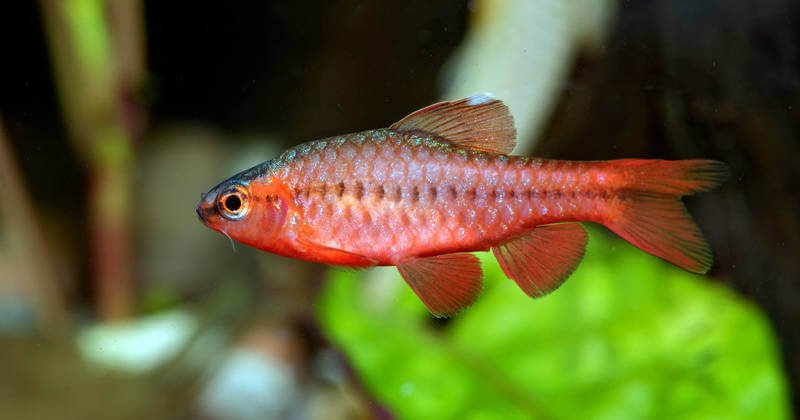
Cherry barbs are native to Sri Lanka. They are typically found in streams and small rivers that have slow-moving current.
With a dense canopy of vegetation above the water, there is not much light penetration where these fish reside. A soft, silty bottom with leaf litter and plenty of plants and driftwood provide the shy barbs with adequate cover.
All of these natural protections make the wild cherry barb more colorful than those in captivity.
Color and Appearance
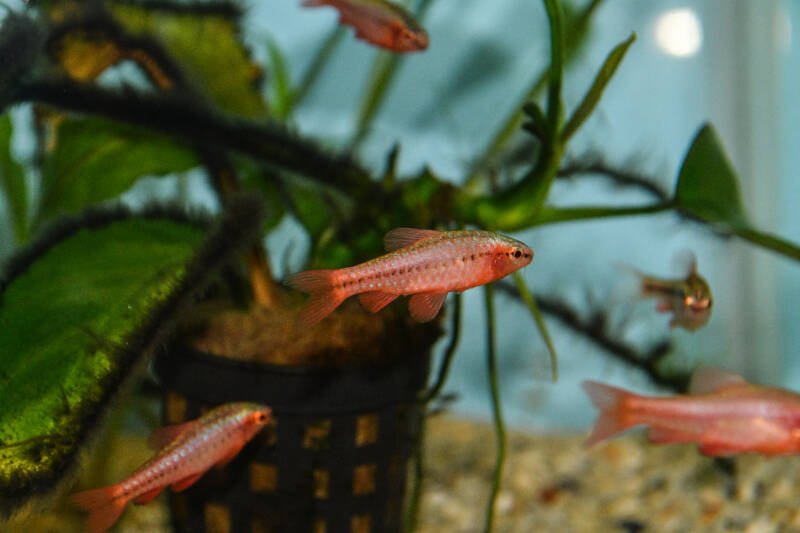
As you may have assumed from the name, the cherry barb has a distinct red coloration that is unique to the species. However, females are not as red as males. In fact, they are more of an orange color.
Both genders have one lateral black line that runs from the tip of the mouth to the tip of the tail.
Cherry barbs have a different body shape than that of most other barbs like the tiger, rosy, and banded barbs. Cherries have a more streamlined and skinny body, whereas the species listed above have a thicker and taller midsection.
Maxing out at a size of 2 inches (5 cm), the adult cherry barb is smaller than a lot of other barbs. The tinfoil barb can reach a size of over 10 inches (25 cm)! Most other barbs range between 2.5 and 6 inches (6-15 cm).
The average lifespan of the cherry barb is 4 years. Though in the wild and well-run tanks, they have been known to reach the ripe old age of 7!
Behavior

Cherry barbs are a notably shy and timid fish. Their schooling instincts are not as strong as other barbs, so it is not unusual to see them spread out and separated from the rest of the group.
However shy, they are very peaceful and do well with other nervous, non-invasive species.
A cherry barb would not be a good addition to any high-activity level aquarium as it will be uncomfortable and spend most of the time hiding.
While most barbs, and tetras, are considered “fin nippers” cherries rarely harass other fish.
Tank Setup

Cherry barbs do best in an aquarium that matches their natural habitat. Tons of live plants, driftwood, and leaf litter give them plenty of security to make them more confident.
Even though they tend to stay in the top or middle range of the tank, a soft sand substrate is preferred but not entirely necessary.
The minimum recommended tank size for these fish is 20 gallons (75 l).
In the wild, the cherry barb can be found in large groups containing many individuals. A good number of these guys for a 20-gallon tank would be anywhere between 6-10. You can get away with a full dozen in an aquarium this size if there are no other fish in the tank.
Too heavy of a bioload can foul the water quality and adversely affect your fish. Keep that in mind when stocking a community tank! Want a larger school? Get a larger tank! The more, the merrier!
A strong filter is not needed as these fish prefer a slow current. Any filter rated for the size of the tank should be appropriate.
If you notice your fish being pushed around by the current, you may need to baffle your filter or purchase one with an adjustable flow rate.
The lighting should be low to moderate. Top floating and large-leaved plants can help obscure the light if need be.
Being a tropical fish, the cherry barb prefer to be in warmer temperatures of 72-78°F (22-25.5°C). They also prefer soft and acidic water with a pH of around 6.0.
Water changes should be done at least once a week. Both the fish and the plants will benefit from it! If you’re changing your water once a week, you should aim for a 30%-50% change, and if you’re changing your water twice a week, you should aim for 20%.
These regular tank cleanings will keep your parameters in check. Healthy parameters equal healthy fish!
Tank Mates
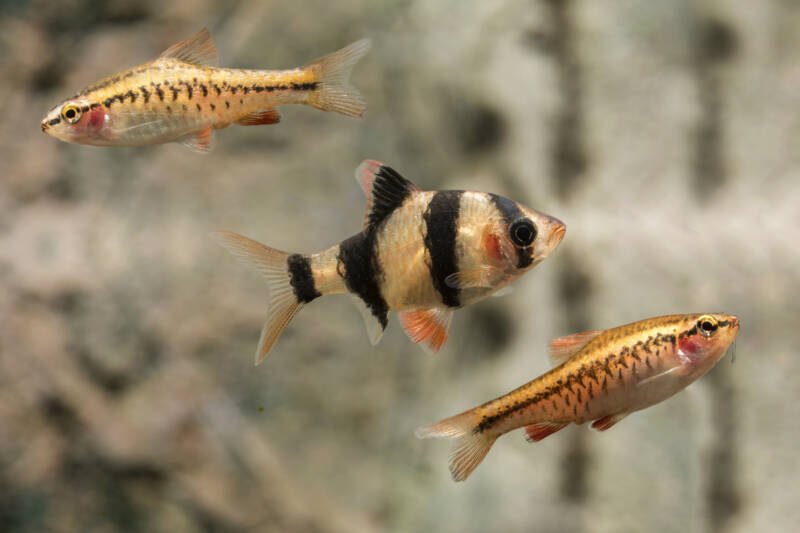
The most appropriate tank mates for the cherry barb would be bottom dwellers, as most are peaceful and stay out of the way. Species like corydoras, black and kuhli loaches, plecostomus, and Asian stone cats are all good additions.
Although non-aggressive to other middle-dwelling fish, they should be the only schooling, mid-level fish in the aquarium.
Too many other, active fish can stress the wary cherry and force them into hiding. Stress can also dull their colors, and nobody wants that!
Invertebrates like shrimp and snails are also good tank mates but be warned that baby shrimp may fall prey to the barbs.
Bad tank mates include any larger, more aggressive species. Highly active fish and fin nippers should also be avoided. Tetras, guppies, bettas, angelfish, cichlids, and larger gourami should be kept clear away from cherries.
Feeding
Being an omnivorous species, cherry barbs can eat a variety of foods.
In the wild, they have been observed consuming crustaceans, algae, diatoms, detritus, and other small organisms. This can be replicated in the home aquarium by feeding live and frozen foods such as bloodworms, daphnia, and brine shrimp.
Quality pelleted food and flakes are a great addition as well and add more balance to their diet.
Tropical based pellets and flakes can be fed along with insect-based foods like Fluval’s Bug Bites.
Cherry barbs have also been observed munching on food made for bottom feeders like algae and veggie wafers. These wafers provide the necessary plant-based foods that are essential to the barb.
Sexing and Breeding
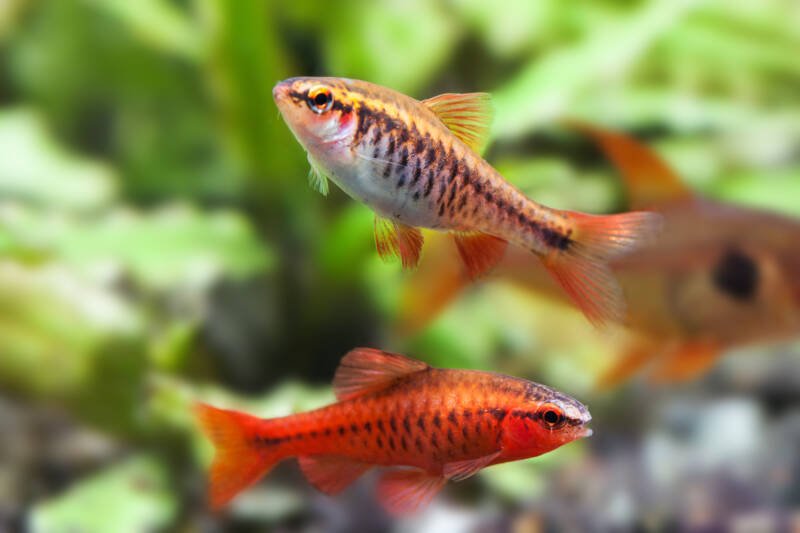
The difference in the sexes is very noticeable in this species.
Male cherry barbs have a bright red color across their entire body. They also have a black stripe that runs laterally across the length of the body.
Females, on the other hand, have a brown base color. Like the males, they also have a lateral black stripe. Unlike the males, the stripe on the female tends to be slightly thicker and more pronounced.
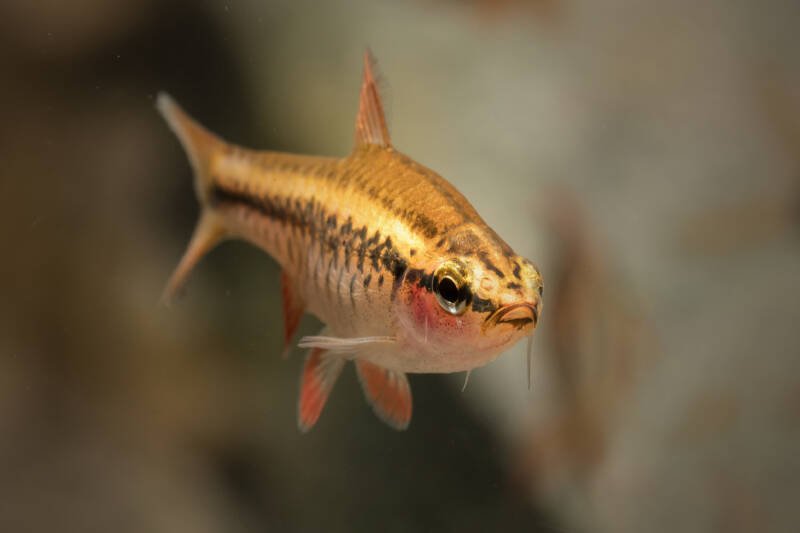
Above and parallel to this black stripe, they have an iridescent orange stripe that pairs nicely with that brownish base color.
They also have a large white belly, making it look like the entire lower half of the fish is white. The only red on the females appears in two places: on the cheek and in the fins.
Cherry barbs are egg scatterers. They release their eggs in plants so that the eggs will stick to the leaves. Because of this, you will need to densely plant your tank if you want to successfully breed this species.
Another reason that dense vegetation is important is that adults tend to eat the eggs. Providing plenty of plant coverage will make sure that the eggs are adequately protected and are less likely to be eaten by hungry parents.
Java moss is a good plant to add during breeding. It adds a ton of little hiding places for the small eggs and fry.
During spawning, the vibrant red color of the males will become much more pronounced. This intensifying color attracts females.
The last thing you can do to optimize the chances of a successful spawning is to provide your breeding pair(s) with live or frozen food a week before the intended “do” date.
This week-long feast will fatten up your fish, brighten their colors, and make them happier and more likely to breed.
If everything goes to plan, the male will soon begin chasing and courting the females. After winning over a willing female, the two will find a suitable spot to lay their eggs. The male and female will wrap around each other.
The male fertilizes the eggs as the female releases them. The eggs are then scattered into the plants, sticking to whatever they come in contact with.
At this point, you may want to remove the adults, so the eggs don’t fall victim to their hungry parents. Some breeders prefer to use a separate breeding tank for this reason.
The eggs will hatch in 24-48 hours. The fry will remain hidden for their first few days and afterward will begin free-swimming around the tank.
The tiny fry should be fed commercially prepared fry food and/or baby brine shrimp and infusoria.
Disease

An incredibly hardy fish, cherry barbs do not often fall ill. Nor do they have any known species-specific diseases or ailments. They can withstand slight levels of ammonia and nitrates. Though not for long!
All fish, including the cherry barb, can become ill after prolonged exposure to ammonia and nitrates, no matter how low!
That’s one reason why weekly water changes are so important. Extended exposure to these chemicals can weaken the immune system. No fish, not even the valiant cherry, is impervious to poor water quality.
That being said, here are a few things you can do to protect your fish against any outside pathogens.
1. Always maintain good water parameters
Any prolonged exposure to low or moderated levels of ammonia and nitrates can cause many problems.
High levels of these chemicals can ultimately cause a quick demise to any fish exposed. Nitrites are deadly at any amount, and an immediate water change should be done if you have any nitrite reading higher than zero.
The most obvious reason why these chemicals are so harmful to your fish is that they compromise the immune system, leaving them more susceptible to disease and other ailments.
High ammonia levels can cause gill burn, which affects the fish’s ability to take in oxygen. It can also cause fin rot.
Fin rot can even take hold with a low amount of ammonia if the fish has been exposed for a long time.
Nitrites are just as dangerous as ammonia, if not more, and usually appear in uncycled tanks.
Nitrites are made when the beneficial bacteria consume ammonia and release it as nitrites.
In established aquariums, the bacteria then turn those deadly nitrites into less harmful nitrates. Most fish can withstand short-term exposure to nitrate levels up to 20 ppm.
All three chemicals can be kept in check with routine water changes. The chemicals will build and sicken the tank inhabitants without those water changes. Fin rot, dropsy, ich, and other infections become a substantial risk in these conditions.
Sudden shifts in temperature can also make fish more susceptible to these diseases. The bottom line, stable parameters make stable fish.
2. Always quarantine new additions to the tank
When purchasing new fish, it’s not always easy to tell whether or not they have any illnesses. Thus, it is important to always quarantine them in a separate tank before adding them with your other fish.
Two to four weeks is the standard quarantine length. This gives the fish ample time to show any signs of the disease. That way, if they are diseased, you can treat them before adding them to the main tank and save your other fish from ever being exposed.
3. Never buy fish that are in a tank with sick or dead fish
This one is pretty obvious. If healthy fish are in a tank with illness-ridden ones, they share the same water and therefore have a high chance of also contracting the illness.
You may be thinking, “But they look healthy, why can’t I get them?” The answer to that is, as previously stated: fish can have already contracted the disease and not be showing any symptoms yet.
They can look just as healthy as, well, healthy fish. This is why quarantine is so important, cause these seemingly “healthy” fish can wipe out your entire aquarium as the disease spreads from fish to fish.
Closing Thoughts
Cherry barbs are fantastic little schoolers. Their hardiness makes them a good freshwater fish for people new to the fishkeeping hobby.
Even experienced keepers can find joy in keeping them. Cherries can add so much color and personality to your quiet, densely-planted tank!
If your aquarium is established and meets all of the criteria above, hurry! Go out and grab a school before your local fish store runs out!
Was this article helpful? Do you have any other questions?
We’d love to hear your feedback, leave some below!